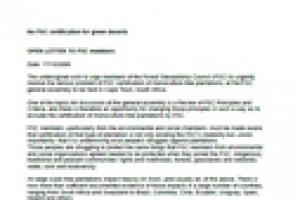Indonesia is one of the world’s most populous and rural countries, with a total population of 220 million people.
Large-Scale Tree Plantations
Industrial tree plantations are large-scale, intensively managed, even-aged monocultures, involving vast areas of fertile land under the control of plantation companies. Management of plantations involves the use of huge amounts of water as well as agrochemicals—which harm humans, and plants and animals in the plantations and surrounding areas.
Other information
30 November 2006
Other information
30 November 2006
Malaysia, together with Indonesia, is the world's leading producer of crude palm oil for export, at a high cost, though. According to a 2005 Friends of the Earth report, 87 per cent of recent deforestation in the country has occurred to make way for palm-oil plantations. Since Malaysian rainforests are some of the most diverse ecosystems on the planet, clearing these areas poses serious threat to countless species of plants and animals.
Bulletin articles
30 November 2006
In 1972, a study conducted by the Massachussetts Institute of Technology (MIT), on growing consumer trends alerted politicians and scientists all over the world. The research titled “The limits of growth” was prepared by an international group of scientists, researchers and industrialists – later to be know as the Club of Rome – and became a classic for the analysis of the relationship between production and environment.
Bulletin articles
30 November 2006
The modalities of biofuel consumption and production are already causing a negative impact on food security, rural livelihoods, forests and other ecosystems, and these negative impacts are expected to accumulate rapidly. Large-scale, export-oriented production of biofuel requires large-scale monocultures of trees, sugarcane, corn, oil palm, soy and other crops. These monocultures already form the number one cause of rural depopulation and deforestation worldwide.
Bulletin articles
30 November 2006
There are some 800 million automobiles in the world, consuming over 50 percent of the energy produced in the world, making individual vehicles the prime cause of the greenhouse effect. Although there is consensus that climate change is a fact, there is no serious intention of changing the life-style causing it and instead, technological solutions are being sought to enable the companies benefiting from this model to maintain their profits.
In this context, over the past years biofuels have started to be promoted as an alternative to global warming.
Bulletin articles
30 November 2006
In July 2006, Pulp and Paper International reported on a conference called World Bioenergy 2006. The conference took place in Sweden, where biofuels provide 25 per cent of Sweden’s energy and the majority of its heating. “Pulp mills with combined heat and power plants sending excess energy to district heating systems are an established part of the country’s infrastructure and a useful source of extra income for its pulp mills,” notes Pulp and Paper International.
Other information
15 November 2006
At its last Conference of the Parties (COP8), the Convention on Biological Diversity adopted a very important Decision in relation to the issue of genetically modified trees and invited everyone “to provide relevant views and information to the Secretariat for inclusion in this assessment”.
Bulletin articles
30 October 2006
Everyone now seems to agree that the Earth’s climate is changing as a direct result of human activities and that the social, environmental, political and economic consequences will be catastrophic if nothing is done – and fast – to address the problem.
Bulletin articles
30 October 2006
The World Bank has become the main international trader of carbon credits. Its new role gives rise to a series of conflicting interests.
Bulletin articles
30 October 2006
The 9th Conference of the Parties of the United Nations Convention on Climate Change held in Milan in 2003 allowed Northern companies and governments to establish plantations in the South under the Kyoto Protocol’s “Clean Development Mechanism” (CDM), allegedly to absorb carbon dioxide and to store carbon. COP-9 allowed the use of plantations of genetically engineered (GE) trees [also known as genetically modified, GM, or transgenic trees] as carbon sinks, that is to supposedly offset carbon emissions
Other information
30 October 2006
I recently had the opportunity of travelling to the Indian province of West Bengal and to visit the Dhoteria, Bagora and Mayung “Forest Villages” in the districts of Darjeeling, Kurseong and Kalimpong.
To the outsider, the mountain area of the Outer Himalayas appears to be covered by dense forests, mostly composed of very large trees. However, local people know that these are not forests, but old and new plantations of mostly two species: the Japanese cedar (Cryptomeria japonica) and Teak (Tectona grandis).
Other information
30 October 2006
Later this year, United Fiber Systems plans to open a new 700,000 tonnes a year wood chip mill at Alle-Alle on the island of Pulau Laut. The mill is the first step of UFS’ proposed pulp developments for Kalimantan. The wood chips will be exported to feed pulp and paper mills in China.

